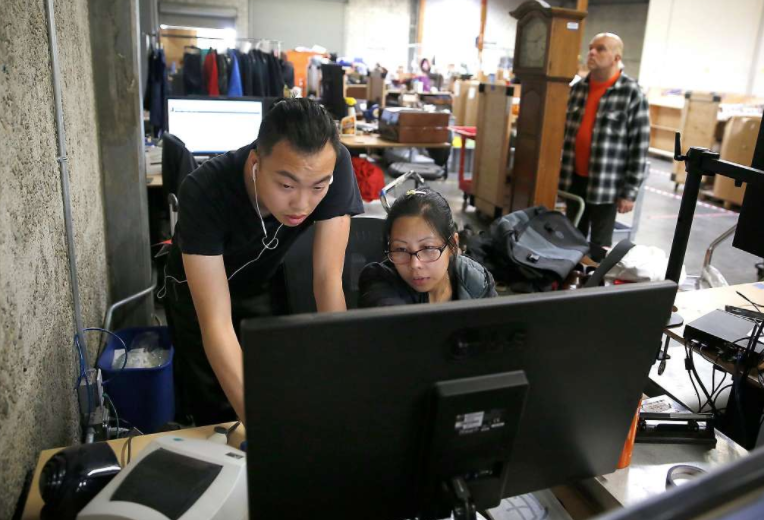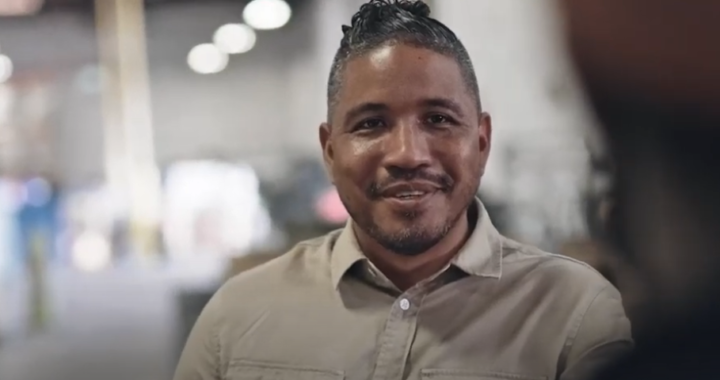By it admin

In a sprawling warehouse, workers under bright lights photograph merchandise destined for sale over the Internet — jewelry, electronics, collectibles. Others crop and edit the images and enter item descriptions. Goods labeled with bar codes sit on rows of shelves, ready to be selected and shipped.
With a mission to hire and train people who face employment obstacles — many were formerly incarcerated or homeless — the Goodwill of San Francisco, San Mateo and Marin is working to ensure that its clients in those counties will learn the right skills to land jobs in the technology economy.
As e-commerce has surged, warehouse work is now among the nation’s fastest-growing job categories, according to the Bureau of Labor Statistics. But warehouses of companies such as Amazon and Walmart often require some digital know-how beyond the ability to drive a forklift or lift heavy boxes.
Rogers, who left a job as Berkeley’s deputy city manager to join Goodwill in 2014, spearheaded the technology initiative out of a deep concern for people left behind by the digital divide.
“If training and education don’t keep pace with technology, the result is inequality,” he said, leading a tour of Goodwill’s South San Francisco warehouse, where workers process up to a dozen trailer-loads a day of used items. The volume is so huge that the warehouse recycles 5 tons a week of cardboard just from the boxes that donations come in. “A lot of our folks don’t have experience with technology besides their cell phones.”
The three-county Goodwill had sold a handful of items — generally higher-value goods plus books — on eBay, Amazon and its own online store for a few years. But under the new tech initiative, those sales have soared 12-fold to more than 1,200 a day. About four-fifths of Goodwill’s $36 million operating budget comes from sales in stores and online; the rest is from grants and donations.
Much of the warehouse work is still low tech: unloading, sorting and pricing items for sale, putting them in boxes or on hanging racks; loading pallets on trucks with forklifts; driving those trucks to its 19 local stores.
But even this aspect has a new high-tech component, with big-screen monitors hanging from the warehouse ceiling to display information such as sales volumes of different categories of items at the various stores, for instance.
“These more real-time tools get people comfortable with seeing and understanding data,” said Pablo Gabatto, director for operations and logistics. “Our workers can see what (the) Clement (store) sold — linens, kids, men’s, women’s, for instance, and can decide where to increase production and not send them items that aren’t selling.”
Gabatto left a job as a research supervisor at UCSF, where he delved into the effects of hypothermia on anesthesia, because he wanted to offer more direct help to people in need. “I’m here for the mission,” he said.
The transportation department has likewise been transformed with Orion Fleet Intelligence hardware and software to monitor all the GPS-equipped vehicles.
“Before, we’d have to call drivers on their cell phone or Nextel walkie-talkies,” said Jesse Edwards, transportation manager. “This completely changes how we deal with transportation. We have real-time visibility of where everyone is, reports on who’s idling or hard-accelerating. That helps with training. Our dispatchers have much more operational efficiency.”
 Goodwill employs about 600 people in the three counties. About 72 people work in the sorting side of the warehouse, while 42 work on the e-commerce site and an additional 60 at a salvage warehouse focused on recycling components of broken items. Goodwill starts most workers at minimum wage with benefits and offers opportunities to change jobs, earn raises and advance within the organization.
Goodwill employs about 600 people in the three counties. About 72 people work in the sorting side of the warehouse, while 42 work on the e-commerce site and an additional 60 at a salvage warehouse focused on recycling components of broken items. Goodwill starts most workers at minimum wage with benefits and offers opportunities to change jobs, earn raises and advance within the organization.
Many workers stay at Goodwill for months or years because they feel more comfortable, Rogers said. In the case of those who spent time in prison, they may have trouble finding other options initially.
About a quarter of Goodwill’s workers each year move on to other employment or education. Alumni of the Goodwill warehouse have recently landed positions in customer support, transportation or warehousing at Tesla, Google, Stitch Fix, ThredUp, FedEx and UPS. Six recently went to the Salvation Army to help restart its e-commerce efforts.
Giovanni Morgia, 39, recently landed a job with Comcast, where he’s a communications technician installing Internet, cable and phone lines. He had moved from the Philippines two years ago, and after starting at Goodwill as a donations attendant, he moved to the warehouse to gain computer skills and learn about logistics, forklift operations and online inventorying.
That provided him the background to work for Comcast. “The Goodwill training gave me the fundamentals to better understand all the systems at Comcast,” he said.
“Goodwill gave me a chance and employed me,” said Morgia, who previously was a timekeeper at a construction company in the Philippines. Other employers would not talk to him while he was resolving his immigration status.
On top of his full-time Comcast job, he still works 16 to 24 hours a week at Goodwill as a donations supervisor, both out of gratitude and to earn more money to support his wife and five children in the Philippines, ages 5 to 17, who he hopes can join him in the United States.
“Goodwill took me in when no one else wanted to take me,” he said.
Cole Hardware in San Francisco has hired about 10 workers from Goodwill over recent years and appreciates them being tech-literate, said Julia Strzesieski, spokeswoman for the six-store family-owned chain. “It’s a skill we really look for because all our inventory is in online control,” she said. “We can train somewhat, but it’s important to hire people who have some experience with technology and aren’t afraid to use it.”
Chris Blazer, 28, has stayed out of loyalty to Goodwill. After getting out of prison at 19, he got his first job in a Goodwill store through a program for at-risk youth. He worked at some other Goodwill stores, then took a computer class, found out that he had a knack for it, and interned with Goodwill’s information technology and facilities department. He’s now a technical support specialist with multiple certifications in networking, security and various software.
“I owe a lot to Goodwill; it saved my life,” he said. “They’ve been invested in my success.”
Will you do Good and share this post?



